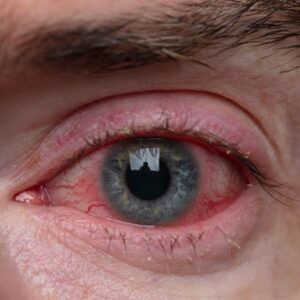Eye pain is a discomfort or a painful sensation in or around the eye area. It can be due to various causes, including eye strain, dry eyes, infections, corneal abrasion, injury, inflammation, or underlying medical conditions.
Eye pain can range from mild to severe and may be accompanied by other symptoms such as redness, watering, headache, or changes in vision. If the eye pain is severe or accompanied by vision changes, it’s essential to seek prompt medical attention.
Who is More Likely to Experience Eye Pain?
Anyone can experience eye pain, regardless of age, gender, or ethnicity. However, some groups may be more likely to experience eye pain due to certain risk factors.
For example, people who work long hours in front of a computer screen, wear contact lenses or have a history of eye injuries are more prone to developing eye pain.
People with certain medical conditions like diabetes, high blood pressure, or autoimmune disorders may also be more likely to experience eye pain due to their impact on eye health.
Additionally, older adults are more likely to experience age-related eye conditions such as cataracts or glaucoma that can cause eye pain. However, it is essential to note that eye pain can occur in anyone, and prompt medical attention should be sought if it persists or causes significant discomfort.
What Parts of Your Eye Might have Eye Pain?
Eye pain can be felt in different parts of the eye, depending on the underlying cause. Some common areas where eye pain can be felt include:
- Cornea: Pain in the front of the eye, especially when exposed to bright light, can indicate corneal abrasion or infection.
- Sclera: Pain in the white of the eye can be a sign of scleritis, an inflammation of the sclera.
- Eye socket: Pain around the eye socket or temples can signify a sinus infection or a headache.
- Retina: Pain in the back of the eye can indicate a problem with the retina, such as a retinal detachment or central serous retinopathy.
- Optic nerve: Pain in the back of the eye and around the optic nerve can be a symptom of glaucoma.
Eye pain can be a symptom of various conditions, and a comprehensive eye exam is necessary to determine the cause and appropriate treatment.
What are The Most Common Causes of Eye Pain?
Some many diseases and conditions can cause eye pain, including:
- Migraines: Migraines can cause eye pain, vision changes, headaches, and sensitivity to light and sound.
- Pink eye (conjunctivitis): Pink eye is an inflammation of the conjunctiva, the transparent membrane that covers the white part of the eye, and can cause eye pain, redness, and discharge.
- Corneal ulcer: A corneal ulcer is a painful injury to the clear outer layer of the eye, causing inflammation and vision changes. An open sore on the cornea can lead to severe discomfort and blurry vision.
- Glaucoma: Glaucoma is an eye condition that causes permanent damage to the optic nerve. Symptoms of glaucoma include eye pain, headaches, and vision loss if left untreated.
- Scleritis: Scleritis is a severe eye condition that causes inflammation of the sclera or the white part of the eye. This inflammation can lead to severe pain, redness, and light sensitivity. It is essential to get treatment for scleritis as soon as possible to reduce potential damage to vision.
- Foreign object in the eye: A foreign object in the eye can cause eye pain, redness, and discomfort.
- Dry eye syndrome: is a condition that occurs when the eyes do not produce enough tears or the quality of the tears is poor, causing eye pain, itching, and sensitivity to light.
- Trigeminal neuralgia: Trigeminal neuralgia is a facial pain disorder that can cause intense eye pain.
- Orbital cellulitis: Orbital cellulitis is a bacterial infection of the tissues surrounding the eye that can cause eye pain, redness, and swelling.
- Eye strain is an issue that arises from spending too much time on digital devices or performing visually demanding tasks. It is usually characterized by eye redness, irritation, dryness, and fatigue.
- Corneal abrasion: an injury to the cornea, usually caused by a scratch or other direct trauma. Symptoms may include sensitivity to light, blurred vision, and a feeling of something in the eye. Treatment includes antibiotics, anti-inflammatory medications, and even surgery in some cases.
- The injury occurs when a person is struck in the eye or has a foreign object enter the eye. These injuries often cause pain and can lead to impaired vision.
- Inflammation: this is a sign of an underlying condition or disease and can manifest as iritis or uveitis. It is characterized by redness, pain, heat, swelling, and sometimes loss of function.
- Sinusitis is an infection in the sinuses that can cause pain in the cheek, forehead, and around the eyes.
See an eye doctor or ophthalmologist if you experience eye pain, as prompt treatment can help prevent vision loss and other complications.
How Can Eye Pain Be Diagnosed?
Eye pain can be diagnosed by an eye doctor (ophthalmologist) or an optometrist through a comprehensive eye examination. The following tests may be performed:
- Visual acuity test: Visual acuity testing is essential to eye care. It involves measuring your ability to distinguish the shape, size, and detail of objects at varying distances. This type of test is used to detect vision problems such as nearsightedness, farsightedness, and astigmatism, as well as eye diseases such as glaucoma and cataracts.
- The slit-lamp exam is a diagnostic procedure used to examine the structures at the front of the eye. It uses a specialized microscope designed to illuminate and magnify parts of the eye, such as the cornea, iris, and lens, to detect signs of ocular disease or injury.
- Tonometry is an eye test that helps measure the pressure inside the eye. This non-invasive procedure is used to diagnose any conditions that might be causing the pressure in the eye to become too high or too low. It can also monitor those with glaucoma or other conditions requiring regular ocular pressure monitoring.
- A pupil reaction is a test used by ophthalmologists to assess the health of the optic nerve. It is done by measuring the size of the pupil’s response when exposed to light. This test can help identify potential damage to the optic nerve, which can signify more serious underlying issues.
- Fundoscopy examines the eye’s interior, specifically the retina and optic nerve. It is often done using an ophthalmoscope or a fundus camera to view the eye’s back better. This helps to detect any signs of disease or injury, as lesions and other abnormalities in the fundus can be readily seen.
- Refraction testing is the process of determining if you need glasses or contact lenses. This test involves measuring how light is refracted as it passes through your eye to help determine the proper amount of correction needed.
- Imaging tests can obtain detailed pictures of the structures within and around the eye. These tests may include ultrasound, magnetic resonance imaging (MRI), or computed tomography (CT) scans.
Based on the results of these tests, the doctor can diagnose the underlying cause of the eye pain and recommend the appropriate treatment. If the pain is severe or accompanied by vision changes, it is essential to seek prompt medical attention.
Treatments for Different Types of Eye Pain
The treatment for eye pain depends on the underlying cause. Some common treatments for different types of eye pain include:
- Dry eye syndrome: Dry Eye Syndrome is a condition caused by dryness of the eyes and can lead to symptoms like irritation, redness, and blurred vision. Treatments such as artificial tears, warm compresses, and avoiding aggravating factors can help ease the symptoms. In more severe cases, a doctor may prescribe medications or recommend a procedure known as punctal occlusion.
- Corneal abrasion: A sterile bandage contact lens, antibiotic eye drops, and pain relievers
- Sinusitis: Over-the-counter pain relievers, decongestants, and nasal sprays. In severe cases, antibiotics may be prescribed.
- Migraines: Over-the-counter or prescription pain relievers, triptans, anti-inflammatory drugs, and anti-nausea medication
- Glaucoma: Medicated eye drops, laser treatment, or surgery to lower eye pressure and prevent further damage to the optic nerve.
- Uveitis: Anti-inflammatory drugs, corticosteroids, or immunosuppressive drugs, depending on the cause and severity of the inflammation
It is essential to consult an eye doctor for an accurate diagnosis and appropriate treatment for eye pain. Some conditions, such as infections or injuries, may require prompt medical attention to prevent further damage to the eye or vision loss.
Natural Remedies For Treating Eye Pain.
In addition to conventional treatments, some natural remedies can help alleviate eye pain:
- Warm compress: Placing a warm, damp cloth over closed eyes can help relieve pain and discomfort associated with dry eyes or sinusitis.
- Blink frequently: Frequent eye blinking helps to hydrate the eyes and reduce any discomfort caused by prolonged eye strain.
- Eye exercises: Eye exercises, such as focusing on distant objects, can help relieve eye strain and improve eye health.
- Hydration: Staying hydrated by drinking plenty of water can help relieve dry eyes and prevent eye discomfort.
- Vitamin C: Vitamin C is essential for eye health and can be obtained through a balanced diet that includes fruits and vegetables.
- Sleep: Getting enough sleep and taking regular breaks from screens can help reduce eye strain and promote eye health.
- Massage: Gently massaging the temples and surrounding areas can help relieve eye pain caused by headaches or sinusitis.
It is crucial to remember that natural remedies may not be effective for all types of eye pain, and in some cases, medical treatment may be necessary. Consult an eye doctor for a personalized recommendation on
how to treat your eye pain.
When To See an Eye Doctor
You should see an eye doctor if you experience any of the following symptoms:
- Pain or discomfort in the eyes
- Blurred or double vision
- Light sensitivity or halos around lights
- Flashes of light or floaters in your field of vision
- Redness or swelling of the eyes
- Dry eyes or excessive tearing
- A sudden change in your vision
- A recurring headache that is accompanied by eye pain
- A feeling that something is stuck in your eye
- Eye injuries or foreign objects in the eye
It is essential to seek prompt medical attention if you experience any sudden changes in your vision or eye pain that is severe or persistent, as these symptoms can indicate a serious eye condition that requires treatment. An eye doctor can diagnose the cause of your symptoms and provide appropriate treatment to protect your vision and eye health.
Conclusion
Eye pain is a common symptom caused by various conditions, ranging from dry eye syndrome to serious eye diseases.
The treatment for eye pain depends on the underlying cause and can range from self-care measures to medical intervention.
In some cases, natural remedies can help alleviate eye pain, but it is crucial to seek professional medical advice to determine the most appropriate treatment for your situation.
If you experience any sudden changes in your vision or eye pain that is severe or persistent, it is crucial to seek prompt medical attention to protect your vision and eye health.






